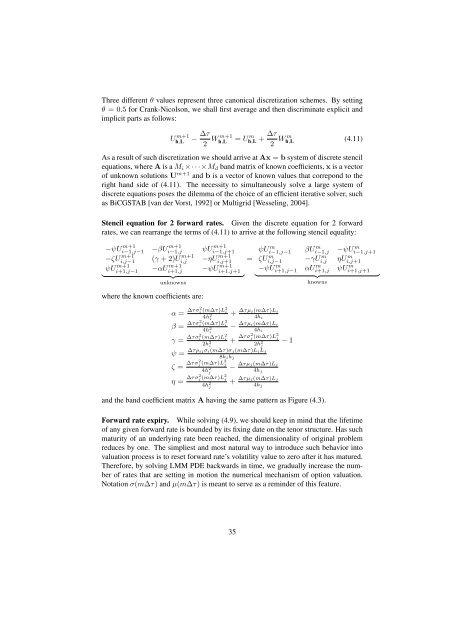sparse grid method in the libor market model. option valuation and the
sparse grid method in the libor market model. option valuation and the
sparse grid method in the libor market model. option valuation and the
Create successful ePaper yourself
Turn your PDF publications into a flip-book with our unique Google optimized e-Paper software.
Three different θ values represent three canonical discretization schemes. By sett<strong>in</strong>g<br />
θ = 0.5 for Crank-Nicolson, we shall first average <strong>and</strong> <strong>the</strong>n discrim<strong>in</strong>ate explicit <strong>and</strong><br />
implicit parts as follows:<br />
U m+1<br />
h,L<br />
− ∆τ<br />
2 W m+1<br />
h,L<br />
= Uh,L m + ∆τ<br />
2 W h,L m (4.11)<br />
As a result of such discretization we should arrive at Ax = b system of discrete stencil<br />
equations, where A is a M i ×· · ·×M d b<strong>and</strong> matrix of known coefficients, x is a vector<br />
of unknown solutions U m+1 <strong>and</strong> b is a vector of known values that correpond to <strong>the</strong><br />
right h<strong>and</strong> side of (4.11). The necessity to simultaneously solve a large system of<br />
discrete equations poses <strong>the</strong> dilemma of <strong>the</strong> choice of an efficient iterative solver, such<br />
as BiCGSTAB [van der Vorst, 1992] or Multi<strong>grid</strong> [Wessel<strong>in</strong>g, 2004].<br />
Stencil equation for 2 forward rates. Given <strong>the</strong> discrete equation for 2 forward<br />
rates, we can rearrange <strong>the</strong> terms of (4.11) to arrive at <strong>the</strong> follow<strong>in</strong>g stencil equality:<br />
−ψU m+1<br />
i−1,j−1 −βU m+1<br />
i−1,j ψU m+1<br />
i−1,j+1<br />
−ζU m+1<br />
i,j−1 (γ + 2)U m+1<br />
i,j −ηU m+1<br />
i,j+1<br />
ψU m+1<br />
i+1,j−1 −αU m+1<br />
i+1,j −ψU m+1<br />
i+1,j+1<br />
} {{ }<br />
unknowns<br />
where <strong>the</strong> known coefficients are:<br />
=<br />
ψUi−1,j−1 m βUi−1,j m −ψUi−1,j+1<br />
m<br />
ζUi,j−1 m −γUi,j m ηUi,j+1<br />
m<br />
−ψUi+1,j−1 m }<br />
αUi+1,j m {{<br />
ψUi+1,j+1<br />
m }<br />
knowns<br />
α = ∆τσ2 i (m∆τ)L2 i<br />
4h 2 i<br />
β = ∆τσ2 i (m∆τ)L2 i<br />
4h 2 i<br />
γ = ∆τσ2 i (m∆τ)L2 i<br />
2h 2 i<br />
+ ∆τµi(m∆τ)Li<br />
4h i<br />
− ∆τµ i(m∆τ)L i<br />
4h i<br />
+ ∆τσ2 j (m∆τ)L2 j<br />
2h 2 j<br />
ψ = ∆τρ ijσ i (m∆τ)σ j (m∆τ)L i L j<br />
8h ih j<br />
ζ = ∆τσ2 j (m∆τ)L2 j<br />
4h 2 j<br />
η = ∆τσ2 j (m∆τ)L2 j<br />
4h 2 j<br />
− ∆τµ j(m∆τ)L j<br />
4h j<br />
+ ∆τµ j(m∆τ)L j<br />
4h j<br />
− 1<br />
<strong>and</strong> <strong>the</strong> b<strong>and</strong> coefficient matrix A hav<strong>in</strong>g <strong>the</strong> same pattern as Figure (4.3).<br />
Forward rate expiry. While solv<strong>in</strong>g (4.9), we should keep <strong>in</strong> m<strong>in</strong>d that <strong>the</strong> lifetime<br />
of any given forward rate is bounded by its fix<strong>in</strong>g date on <strong>the</strong> tenor structure. Has such<br />
maturity of an underly<strong>in</strong>g rate been reached, <strong>the</strong> dimensionality of orig<strong>in</strong>al problem<br />
reduces by one. The simpliest <strong>and</strong> most natural way to <strong>in</strong>troduce such behavior <strong>in</strong>to<br />
<strong>valuation</strong> process is to reset forward rate’s volatility value to zero after it has matured.<br />
Therefore, by solv<strong>in</strong>g LMM PDE backwards <strong>in</strong> time, we gradually <strong>in</strong>crease <strong>the</strong> number<br />
of rates that are sett<strong>in</strong>g <strong>in</strong> motion <strong>the</strong> numerical mechanism of <strong>option</strong> <strong>valuation</strong>.<br />
Notation σ(m∆τ) <strong>and</strong> µ(m∆τ) is meant to serve as a rem<strong>in</strong>der of this feature.<br />
35
















